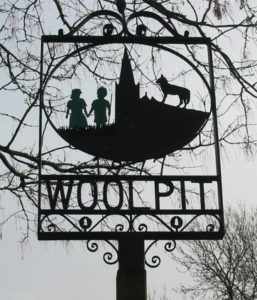
Hosted by Long and Short Reviews.
Click here to read everyone else’s replies to this week’s question and to read everyone else’s replies to this week’s question and here to see the full list of topics for the year.
 My favourite sorts of fairy tales or legends are the ones based on true stories.
My favourite sorts of fairy tales or legends are the ones based on true stories.
For example, I am endlessly fascinated by The Green Children of Woolpit.
It was harvest time during the reign of King Steven (so somewhere between 1135 and 1154). A boy and a girl who had green skin, spoke a strange tongue, and were wearing odd clothing appeared in the village of Woolpit.
They were taken to the home of Richard de Calne and refused to eat anything until someone finally offered them broad beans a few days later. That was the only food they ate for a time, although they gradually adapted to the typical diet of people living in the U.K. in the 1100s. Their skin slowly lost its green hue during this adjustment period as well.
One version of the story says the boy died soon after he was baptized. In another version, both children lived and began sharing stories of their previous life once they learned to speak the language of their rescuers.
The girl (or the children) said they came from St Martin’s Land where everything was green, the sun never shone, and the sky always looked like twilight. She or they said they’d found their way to Woolpit while they were out herding their father’s cattle and heard a loud noise.
Her rescuers named the girl Agnes, and she was a servant in Richard de Calne‘s home for many years before she married someone named Richard Barre.
Did these kids come from a magical alternate reality? Or had they simply gotten lost in the forest and wandered in from a village that was just far enough away from Woolpit that the folks there didn’t recognize their language or clothing?
Travelling was much harder back then, after all, and the local cultures, languages, and customs could change dramatically from place to place.
As for their green skin, was it a mistranslated description of children who might have had complexions that were a little darker or lighter than expected? Were they aliens from another planet? Did they have chlorosis (iron-deficiency anemia) which can cause a green hue to the skin but disappears once you have a better diet? Or maybe they had a case of mild arsenic poisoning that killed the boy but that little Agnes survived?
Some people think this tale is much, much older than the 1100s. Maybe the children are an allusion to the first human inhabitants of Europe who were all but completely replaced by new waves of immigrants to that continent between 5,000 and 9,000 years ago.
Something can evolve a lot over the generations while still retaining a kernel of truth about the people or places featured in it, after all. There is an aboriginal tribe in Australia who has a legend about a violent meteor strike that scientists recently confirmed really did happen 4,700 years ago.
So I think it’s plausible that some of the other “myths” people like to share could be just as old as that one even if certain details might have changed over the years depending on how rigorously a culture trains their storytellers on getting every word right.
The possibilities are endless. You can chalk everything up to purely logical explanations or choose much more fanciful ones if you prefer. Either way, I think this is an excellent story and I wish we knew more about what happened to Agnes after she got married and where she really came from.
